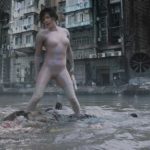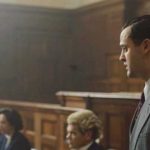
Dark Destroyer – Alien: Covenant
Posted on Aug 30, 2017 by Julian Mitchell
The eighth film in the epic sci-fi franchise, the new Alien: Covenant movie recalls the tone of the first time we met the acid-blooded xenomorphs
Watching an Alien movie makes you wonder why the crew members of the various space craft haven’t. Dark moody planet, corporate agendas and a feeling of dread – the clues are there, c’mon! But we all subscribe to the conceit and eagerly wait (or not) for the horror to unfold.
Stephen Nakamura is a high-end finishing colourist out of Company 3 in LA and has been working with director Ridley Scott and DOP Dariusz (Darek) Wolski for a number of alien encounters. “Ridley has got this ship running so well. Everyone knows what is expected of them so there is no panic just a superb creative environment. He works very hard to achieve that.”
We talked with Stephen as he had just finished the HDR version of the movie, “Darek has just signed off on the HDR, home video and Rec. 709 versions. The IMAX is done so all the deliverables are signed off on.”
We wondered what his brief was this time as most people know what has gone before, “this one’s a little bit different. Prometheus had a definite look and there are some similar looks to this one, but it actually has a little bit of a different feel to it. Especially when the movie starts off, it has a very different look in a new area.
“Most important is picking the LUT to carry all the way through to your finishing stage”
“But generally it’s a lot more desaturated than previous versions and there’s dark texture everywhere. When you shoot things that are sometimes dark, in a really weird way you can see more; you can actually pay attention to texture more. A lot of the movie is crafted at night, there are things inside of the spacecraft that are dark and only lit by panels so inherently there’s a darker, heavier feel to the whole thing. Of course when you have all of these people in dark outfits in the spacecraft and caves you’re getting that feel – there’s very little of the movie that’s day exterior.
“This is a particular palette that they picked and it kind of lends itself to that and this palette really helps to tell the story that Ridley and Darek came up with. It’s a lot heavier look than all the other movies that we’ve done. It definitely feels different but it definitely works. There are several scenes where it’s very saturated but it looks great and really helps to add to the tension.”
Dancing in the dark

When a colourist approaches such a narrative look like this with so many deliverables to grade, where does he start? They’re driven by the palette but have a responsibility to make it look better. “There is a conceptual idea that they have and then they do their dailies in Rec. 709. They sort of paint a picture of what they want the movie to look like. Certainly when you’re looking at it on a 50in monitor when you’re crafting dailies, as opposed to having the images in a completely dark room on a 30ft screen, the feel is quite different.
“What I don’t want to do is make images that are very heavily manipulated. There are some types of movie where you can really tell that something’s been done; this isn’t one of those. We just want to live in a world in a certain palette.
“We want you to sit in a theatre and go ‘hey, that’s really interesting’. We want you to live in that world the whole time. What that means is certain scenes, depending on the costume design and the production design, I have had to pop a little bit more colour in there because it might get too electronic looking. Sometimes there maybe trees that are too saturated and I’ll have to pull that down; other times we may have scenes where there may be just steel and rock and things like that with no colour. At that point we have to put in more skin tone otherwise the whole shot is looking black and white. It’s like an overall feel shot by shot, scene by scene. Crafting that you live in a certain world, there are some scenes where the production design has a lot of colour everywhere with coloured and neon lights. Other times there are no lights and there’s no colour in the shot. Then we have to put some regular colours back in and it still feels the same. That’s how I approach it, in a shot by shot kind of basis.”

Like most creative collaborations Alien: Covenant started off with a big conversation. Stephen is a big believer is making sure the pipeline or chain that those conversations start remain solid as otherwise that’s where mistakes creep in. “In this case you’re talking about a group that has been working together for a very long time, Ridley, Darek, his DIT Ryan and myself. So at the start of production we do camera tests and Darek determines which camera he wants to use. At that point we decide on a look-up table, as the finishing colourist I advise Darek that this is the LUT we should use to maximise the look of the this camera. Once we’ve done that we can do anything we want with it. You can make it saturated, desaturated – you can do whatever you want but that initial LUT that you choose to finish a movie in, the one that you choose to give to VFX to work with, is the hugest component to everything going smoothly.
“Once you choose that LUT then you say ‘Everyone, we’re finishing in P3, we’re going to give you a subsequent Rec. 709 LUT thatmatches this kind of look so you can do your work on SRGB monitors for VFX’ and then everyone is kind of working the same way. Ryan on set is working with that same LUT except it’s crafted for Rec. 709 and the DIT then can do colour corrections in a CDL and the CDLs come right back to me. For me it’s an amazing starting point because I already know what they’re going for. So part of the chain that is most important is picking the LUT to carry all the way through to your finishing stage. If that LUT somewhere in that chain is busted then things unravel. But if you work with it properly it’s like clockwork.”
You can understand this. The DOP wants his or her movie to look a certain way but if you use an LUT that has a limited palette or several LUTs that have a limited palettes, you may have problems. “It’s a hard record-keeping process to start with but the bigger thing is you’re basically making decisions on a computer monitor at that point, you’re really crafting those images based on a monitor on set. A Rec. 709 monitor on set is not giving you the full dynamic range that you’re going to have in P3 projected. It’s not going to give you the same dynamic range as HDR which at some point is going to be the dominant electronic format. So what you’re basically doing is, and this is a hard concept to grasp, when you think something is right on a particular exhibition device, someone else might see it on another exhibition device and think it’s desaturated. You may not think it is. You might then realise that the LUT you have designed is very limiting. But if you basically craft everything through that LUT including VFX, you are not going to be unable to dig yourself out of that on the back end. If you got yourself a wider LUT at that point then everything falls apart. This problem comes up all the time.”

For Alien: Covenant mostly everything was straight grade with power windows and stuff like that, secondaries were mostly for things like trees. “Day exterior trees are disproportionately heavily treated, you always have to pull back on that. But in general there weren’t too many secondaries; the movie doesn’t have a very colourful palette to start with so there’s trees and a wheat field scene where I crafted the wheat a certain colour, but that was about it.”
Highlight the low light
The amount of light that the DOP had in some situations in this movie was very little. This is a big learning curve for cinematographers, as is HDR. Darek Wolski realised that with HDR he has had to rethink the way he lights things because of the way HDR makes things look. This is a constantly evolving process with the new cameras, the new lights and new exhibition mediums. Stephen has a great view on this, “Film was crafted to have a certain type of image at 14 footlamberts bouncing off a screen and we now have technology like HDR where we have 1000 nits and 300 footlamberts. When cinematographers have learnt to prep images on 14 or 30 footlamberts it’s a constantly evolving process.







